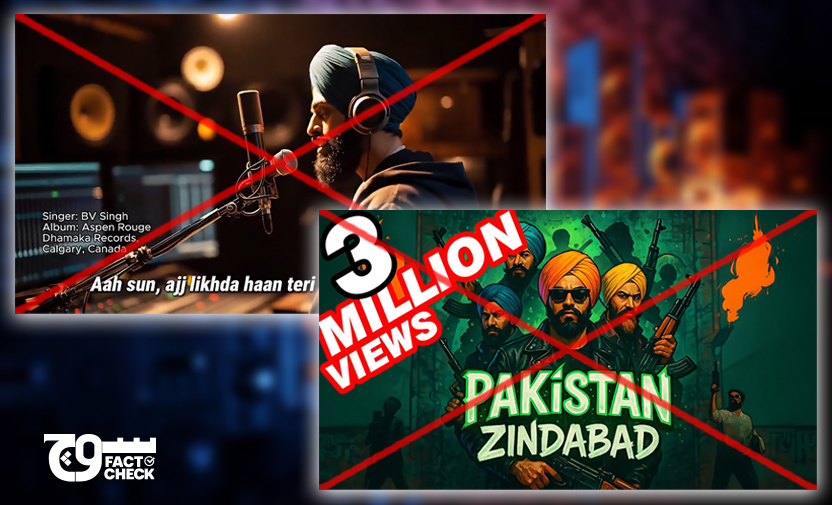
Claim: An Indian-Canadian Sikh singer named BV Singh released a song called “Pakistan Zindabad,” which criticises Indian government officials, praises the Pakistan Army and Operation Bunyan-um-Marsoos, and supports the Khalistan movement.
Fact: The music video was created synthetically, likely using AI tools, especially the shots of BV Singh in the recording studio. There is no evidence that such a singer or a track exist either.
On 18 July 2025, Facebook user ‘ام حریم’ posted the music video (archive) of a song by a so-called Indian singer BV Singh, allegedly expressing the Sikh community’s support and praise for Pakistan.
The video — which has garnered over 107,000 views, more than 4,400 reactions, and upwards of 800 shares — shows that the Sikh community has apparently lauded Pakistan and its military for Operation Bunyan-um-Marsoos that was launched against India after it launched a surprise attack on the country in May 2025.
The Facebook post carrying the song is accompanied by the following caption:
“سکھوں کا آپریشن بنیان مرصوص کی فقید المثال کامیابی پہ پاکستان اور پاک فوج کو خراج تحسین ✌ بھارتی سکھ گلوکار بی وی سنگھ نے پاکستان کی حمایت میں نغمہ گایا اور سکھ برادری کی پاکستان سے ہمدردی اور خالصتان تحریک کی کھلی حمایت کا اظہار کیا گانے میں بھارتی حکومت خاص طور پر نریندر مودی, امیت شاہ اور اجیت دوول کو سخت تنقید کا نشانہ بنایا گیا جبکہ پاکستان کی فوجی طاقت اور استقامت کو سراہا گیا اس نغمے میں بھارتی فوج کی مبینہ ناکامیوں, اندرونی حملوں اور کسانوں کے ساتھ حکومتی ناروا سلوک کا ذکر کیا گیا پنجابی عوام کے جذبات کو اجاگر کرتے ہوئے خالصتان زندہ باد اور پاکستان زندہ باد جیسے نعرے لگاٸے گٸے اس نغمے نے ناصرف سوشل میڈیا پر سکھوں کی دلی دلچسپی کا اظہار کیا ہے بلکہ یہ عوامی توجہ اور بحث و مباحثے کا مرکز بھی بن چکا ہے۔ سکھ پاکستان کی حمایت کا کھل کے اظہار کررہے ہیں۔
[Sikhs pay tribute to Pakistan and the Pakistan Army for the unprecedented success of Operation Bunyan-um-Marsoos ✌ Indian Sikh singer BV Singh sang a song in support of Pakistan, expressing the Sikh community’s sympathy for Pakistan and open support for the Khalistan movement. The song severely criticised the Indian government, especially [Prime Minister] Narendra Modi, [Home Minister] Amit Shah, and [National Security Advisor] Ajit Doval, while praising Pakistan’s military strength and resilience. The song mentioned the alleged failures of the Indian Army, internal attacks, and the government’s mistreatment of farmers, highlighting the feelings of the Punjabi people. Slogans like ‘Khalistan Zindabad’ and ‘Pakistan Zindabad’ were raised. This song has not only expressed the heartfelt interest of Sikhs on social media but has also become the centre of public attention and debate. Sikhs are openly expressing their support for Pakistan.]”
It starts with details of the song on the bottom-left corner, stating the name of the singer as “BV Singh,” album as “Aspen Rouge,” music label as “Dhamaka Records,” and the location as “Calgary, Canada.” It features shots of a turbaned man in a studio, interspersed with those of Modi, Shah, and Doval.
The video also includes file footage from the Khalistan movement-related protests and rallies, Pakistani armed forces’ parades and exercises, various airstrikes, Indian Army’s Col Sofiya Qureshi, a shot of American Sikh political activist Gurpatwant Singh Pannun, the 2020-2021 farmers’ protest, a clip of the militant Balochistan Liberation Army (BLA) hijacking a train in March 2025, and the flags of Pakistan, Khalistan movement, and the farmers’ movement, as well as the Nishan Sahib.

Soch Fact Check also received the same video on WhatsApp with the following caption:
“بھارتی سکھ گلوکار بی وی سنگھ نے پاکستان کے حق میں نیا گانا ریلیز کردیا۔ پوری بھارتی حکومت اس گانے کو یوٹیوب سے ڈیلیٹ کرنے میں مصروف ہے اسلئے سب پاکستانیوں پر فرض ہے کہ یہ گانا ہر جگہ شئیر کریں 👇
[Indian Sikh singer BV Singh has released a new song in favour of Pakistan. The entire Indian government is busy deleting this song from YouTube; therefore, it is the duty of all Pakistanis to share this song everywhere 👇]”
India-Pakistan conflict
In May 2025, India and Pakistan engaged in the most extensive four-day conflict in decades, exchanging drones, fire, shelling, and missiles and bringing the two nuclear-armed nations to the brink of an all-out war.
The conflict was triggered by the killing of at least 26 people by assailants at a resort in Pahalgam in the Indian-administered Jammu and Kashmir on 22 April. New Delhi blamed Pakistan for the attack, a claim which has been denied by Islamabad.
India subsequently launched missiles on what it claimed were “terrorist bases” in Pakistan-administered Kashmir and some sites in the Punjab province on 7 May. The missile attack initially killed 31 people, including women and children, according to an Associated Press (AP) report that cited the Pakistani military.
Both sides exchanged heavy shelling across the Line of Control (LoC) in the subsequent days, according to different reports. On the first day of the conflict, Pakistani authorities claimed they had shot down at least five Indian jets.
After launching missiles, India also sent Israeli-made Harop drones to Pakistan, which were reportedly shot down by the army. Soch Fact Check visited and investigated the attacks at two crash sites each in Karachi, Rawalpindi, and Lahore; read our on-ground report here.
The conflict escalated thereafter, with both sides targeting each other’s military bases.
The total death toll was 51, including “40 civilians and 11 military service members”, while close to 200, including 121 civilians, were wounded, according to the Pakistan Army.
On the other hand, India announced that 21 civilians and five soldiers had died.
On 10 May, US President Trump announced a ceasefire, which was then confirmed by Pakistan’s Foreign Minister Ishaq Dar and later by India’s Foreign Secretary Vikram Misri.
Trump’s announcement came after US State Secretary Marco Rubio spoke separately to Pakistan Army Chief Field Marshal Syed Asim Munir, Foreign Minister Dar, and Indian External Affairs Minister Subrahmanyam Jaishankar.
On the other hand, Pakistan expressed gratitude to the US, with Prime Minister Shehbaz Sharif thanking Trump “for his leadership and proactive role” and Vice President JD Vance and Rubio “for their valuable contributions for peace in South Asia”.
Fact or Fiction?
Soch Fact Check searched for whether any musician named BV Singh — or B.V. Singh — exists but did not find anything relevant.
We did not come across any reliable information or supporting evidence, like links to an actual song or reputable news source, that such an artist exists.
Based on the searches we conducted using different key phrases, there seems to be no widely-recognised Indian-Canadian Sikh singer or even a notable artist named BV Singh. No such musician or their official profile is available on major streaming platforms, like Spotify, Apple Music, Amazon Music or YouTube, or on the Internet-based encyclopedia Wikipedia either.
Songs titled “Pakistan Zindabad” on Spotify, Apple Music, Amazon Music or YouTube do not include any track by a “BV Singh”. The platforms did include authentic songs with the same name, released in the past by musicians such as Rahat Fateh Ali Khan (2018 and 2025), Sahir Ali Bagga (2019), Aayat Arif (2020), Happy Singh (2022), and Shumail Maqbool Sabri (2025).
Apart from the low-credibility channels and pages that rehashed the purported song by BV Singh in its entirety or copy-pasted widely-used post captions, there is nothing verifiable. No track titled “Pakistan Zindabad” was found in music databases nor are there any credible reports of such an individual releasing a song with this name.
The possibility that BV Singh is an obscure or emerging artist not yet covered by mainstream sources is unlikely, mainly owing to a lack of digital footprint. Moreover, the music video does not feature a professional logo for the record label nor does it include consistent branding.
Song identification apps
Soch Fact Check also used multiple song identification applications to see whether they would pick up the lyrics from the purported track, titled “Pakistan Zindabad”, by BV Singh but to no avail.
Shazam, SoundHound, and AHA Music did not find a match for such a song.

(Top, L-R) Results from Shazam, SoundHound, and AHA Music; (Bottom, L-R) Cyanite AI and Google’s machine learning algorithm
On the other hand, while Cyanite AI and Google’s machine learning algorithm did not find any matches on the first attempt either, both provided some unrelated tracks on the second try.
Google’s machine learning algorithm yielded a maximum of 7% match but nothing relevant turned up.
Tell-tale signs of AI
Soch Fact Check observed multiple tell-tale signs of content generated using artificial intelligence (AI), specifically in the studio visuals of the song.
The lips of the singer are out of sync, his neck is slightly distorted at the base, and his hand movements in different portions of the clip — specifically at the start and the 1:14 mark — are unusual and more animated than they should be. The wire of his headphone also merges into his shirt.
Moreover, the design on the side of his headphones varies across at least three points in the video. The length of the mic stand also expands in length over time.
We observed that the camera focusing on the singer moves as opposed to being fixed in a position as it would normally be in the shot of a music studio.
In addition, the lighting in the studio shots appears unusually uniform and lacks natural inconsistencies that are typically seen in real-world settings. The background and the walls of the studio look airbrushed, lacking depth and texture.
Deepfake detectors
Soch Fact Check consequently ran the video through multiple deepfake detectors, such as DeepFake-O-Meter, Hive Moderation, Attestiv, Zhuque AI Detection Assistant, and Resemble AI.
Of the detectors available on DeepFake-O-Meter, a tool developed by the University at Buffalo’s Media Forensics Lab (UB MDFL), we used AVSRDD, AltFreezing, SBI, and WAV2LIP-STA. According to the results, the probabilities of the video being AI-generated are 100.0%, 19.4%, 58.7%, and 68.6%, respectively; the combined average, therefore, is 61.7%.
Hive Moderation turned up an aggregate score of 99.6%, concluding that the video overall “is likely to contain AI-generated or deepfake content”.
Attestiv, on the other hand, said parts of the video in question “are very suspicious”, with a Technical Suspicion Rating (TSR) of 99 out of 100.
Zhuque AI Detection Assistant yielded a 78.94% probability of the video being synthetically-created, saying it was “likely AI-generated”.
Additionally, Resemble AI labelled the video as “fake”.

(Top to bottom) Results from AI detection tools such as DeepFake-O-Meter, Hive Moderation, Attestiv, Zhuque AI Detection Assistant, and Resemble AI
Comments from experts
Soch Fact Check spoke to Umar Akhtar, a cinematographer for Soch Videos, our sister company, and visiting lecturer at the Aawaz Institute of Media and Management Sciences (AIMS) in Karachi.
Akhtar explained that there was an “unnatural reflection” in the microphone mount, the eyes have “deep shadows” despite a strong light on the singer’s face from the front, and that the “nose shadows are soft and inconsistent”.
Moreover, “micro shadow details are missing”, there is a lack of other details, such as texture, in the headphones, and no chromatic aberration on blur was observed, he said. The hair — facial and on the head — appears too perfect and smooth but should be slightly uneven, he said, noting that the edge of the beard, near the jawline, has a “mushy transition”.
We also reached out to Aleem Zahid Khan, the director of photography (DoP) at Eckova Productions and former videographer for Coke Studio, a Pakistani TV programme featuring studio-recorded music performances.
Khan observed that the studio shots are AI-generated. “The look and feel of the footage has that AI look, which we mostly get with the Leonardo AI or Kling AI [tools],” he said, noting that the “lip sync and the expressions of the singer are not match(ing) with the lyrics and energy of the song”.
The two mics in front of the singer are in an “abnormal position”, he further explained. “The monitor screen in the background showing the audio software [is] showing abnormal screen activity. For example, [at] 20-24 seconds, the bar on time timeline [is] going backward and forward, [as well as] the bar covering the entire screen, even the taskbar,” he said.
In many of the shots, the bar on the screen in front of the singer is not there at all, Khan noted, highlighting that in reality, it only appears during playback and not while recording.
Comparing the clip in the claim to how music videos are actually recorded, he mentioned that there is only a single shot from one angle in the entire song, indicating that something is unusual. This is “because creating multiple shots in the same environment and with the same character is not an easy task for an AI beginner”, he said. He added that it usually requires a “little bit of advance(d) knowledge and information [about] how seed systems work in AI”.
A seed is basically the “starting point” of a number series that guides AI in image generation, according to NightCafe Studio. More specifically, it “is a value used to initialise a random number generator (RNG), a critical component in many AI operations,” which is there to ensure “this randomness can be controlled and replicated”, according to this Medium blog.
Khan further mentioned that at least three of the shots were taken by him for different films for the armed forces. As evidence, he provided the link to his own Instagram post documenting the original and behind-the-scenes footage.
Sound engineer’s observations
Soch Fact Check also sought a comment from Shaur Azher, a lecturer who teaches sound design and sound recording at the University of Karachi and the Shaheed Zulfikar Ali Bhutto Institute of Science and Technology (SZABIST). He also works as an audio engineer at our sister organisation, Soch Videos, and specialises in mixing and mastering audio.
Azher said he isolated the vocal stem from the song using a spectral editor, following which the resultant sample “exhibited multiple characteristics, such as no breath [sounds], perfect segmentation, hard spectral cut-offs, uniform loudness, absence of natural consonant transients, smooth vibrato, and fixed formants”.
This is “highly consistent” with AI-generated content created using the text-to-speech (TTS) method or “otherwise synthetic vocals rather than a naturally-recorded human performance”, he noted.
To support his conclusion, he provided a list of characteristics he observed in the sample:
- Breath and mouth noise: No audible or visible breath sounds, lip noise or mouth clicks [pops] were detected between phrases.
- Edit irregularity: The waveform and spectrogram show perfectly-segmented sections after almost every word, indicating uniformly-spaced edits, rather than the variable edits normally seen in a natural composition.
- Overtone structure: Harmonic overtones are present, but their distribution appears unnaturally clean.
- High-frequency content: The spectrum shows very low energy between 20 and 200 Hertz (Hz) and a hard low-pass filter at approximately 15,000 Hz. This is atypical of raw studio vocals, which usually retain some variability above 15,000 Hz.
- Microdynamics: Loudness (LKFS) remains nearly identical across phrases, suggesting a uniform loudness process rather than natural dynamic variation.
- Attack/decay of consonants: Consonant transients and sibilance are largely absent, which is unusual for a real voice even after heavy processing.
- Pitch drift & vibrato: Pitch movement is mathematically smooth, lacking the irregular vibrato or micro-intonation shifts characteristic of human singing.
- Formant shifts: Formants appear fixed rather than shifting subtly with pitch and dynamics.
- Detector results: Both Undetectable AI and Resemble AI classified the audio as fake.
Azher explained that a “hard low-pass filter” means cutting away the very high-pitched portion of a sound so that only the deeper parts remain. LKFS — which stands for Loudness, K-weighted, relative to Full Scale — is just a standard way to “show how loud something feels to our ears”.
Quick, sharp sounds — like finger snaps, claps or cymbals — are called “transients,” while “sibilance” is the hissy “s,” “sh” or “ch” sound that human mouths make, he mentioned. “Pitch drift” means the voice slowly goes off-tune and “formant” is the natural shape or tone of a person’s voice, which here sounds a bit blocked or held back.
“However, without direct access to the original recording session or production documentation, it is impossible to state with 100% certainty that the vocal is artificial; it can only be said that it strongly resembles synthetic or AI-generated audio,” Azher concluded.
Online AI tools to generate songs
Interestingly, we also found that online AI-based song generation tools, such as MusicHero.ai, Suno, and AIMusic.so, provide services allowing anyone to create entire tracks with text-based prompts.
There are also instances where AI tools are used to transform authentic Punjabi songs into voices of popular singers, such as this one and many other experiments by BrownBoy Culture, a “Panjabi Culture Inspired” creator and clothing brand whose description says they are “AI Masters”.
Real ‘Dhamaka Records’
Soch Fact Check did come across an authentic label company called “Dhamaka Records,” with social media presence on YouTube, Instagram, and X (formerly Twitter), where their latest posts are from 26 January 2025, 25 January 2025, and 3 February 2024, respectively.
However, the music company does not have any song called “Pakistan Zindabad” nor any track by a singer named “BV Singh.”
AI slop
When we searched for the record label “Dhamaka Records” alongside other keywords, we were led to a 15 July 2025 post (archive) by X account @DhamakaAI, with the following caption:
“🚨🚨بھارتی معروف سکھ گلوکار بی وی سنگھ نے حال ہی میں پاکستان کے حق میں ایک نیا گانا جاری کیا ہے، جو امن، بھائی چارے اور حقیقت گوئی کا عکاس ہے۔ بتایا جا رہا ہے کہ بھارتی حکومت اس گانے کو مختلف پلیٹ فارمز سے ہٹانے کی کوشش کر رہی ہے۔ ایسے میں ہم سب کی ذمہ داری ہے کہ ہم اس آواز کو پھیلائیں اور اس پیغام کو آگے بڑھائیں جو سرحدوں سے بالاتر ہو کر انسانیت اور سچائی کی بات کرتا ہے،
[🚨🚨 Renowned Indian Sikh singer B.V. Singh has recently released a new song in support of Pakistan, which reflects themes of peace, brotherhood, and truthfulness. It is reported that the Indian government is attempting to remove this song from various platforms. In such a situation, it is our collective responsibility to spread this voice and promote the message that transcends borders, speaking of humanity and truth.]”
It appears that the music video is a combination of political narrative and music studio shots that are “AI slop,” a term used for mass-produced, low-quality, synthetically-generated content. These can include low-effort deepfakes and voice clones that may sometimes be automatically churned out, with minimal human effort, and their creators earn money in some cases.
The account has also uploaded multiple other posts with similar political content. Since it has a verified blue checkmark, it is likely also earning money through X’s Creator Revenue Sharing programme, which is “available globally to creators who meet the eligibility requirements”.
To summarise, the claim originated primarily on social media platforms, where it was quickly shared by numerous users with similar or identical captions, but does not have any source or verifiable information. Thus, Soch Fact Check concludes that it appears to be part of a coordinated disinformation effort, rather than a song by an actual singer.
Virality
The post by Facebook user ‘ام حریم’ has been viewed over 107,000 times so far.
Soch Fact Check found the song shared here, here, and here on Facebook, here, here, and here on Instagram, and here, here, and here on Threads.
It was also posted here, here, and here on X, here, here, and here on YouTube, and here on LinkedIn.
On TikTok, it was uploaded here and here.
Public News, a Pakistani media outlet, broadcast a report about the song here, where it has received over 255,500 likes so far.
Conclusion: The song is created synthetically, likely using AI tools, especially the shots of BV Singh in the music studio. There is no evidence that such a singer or a track exist either. A sound engineer noted that it is “highly consistent” with AI-generated content as opposed to “a naturally-recorded human performance”. Soch Fact Check was able to trace it to an X account. The video does contain some authentic file footage, such as the Khalistan movement-related protests and rallies, Pakistani armed forces’ parades, rehearsals, and exercises, Indian Army’s Col Sofiya Qureshi, and the 2020-2021 Indian farmers’ protest, among others.
Background image in cover photo: Soch Fact Check & Soch Videos
To appeal against our fact-check, please send an email to appeals@sochfactcheck.com
